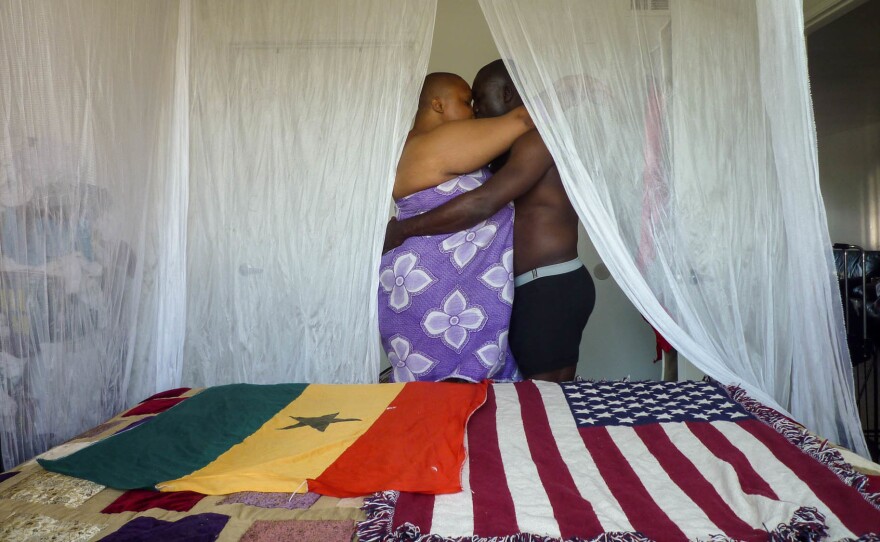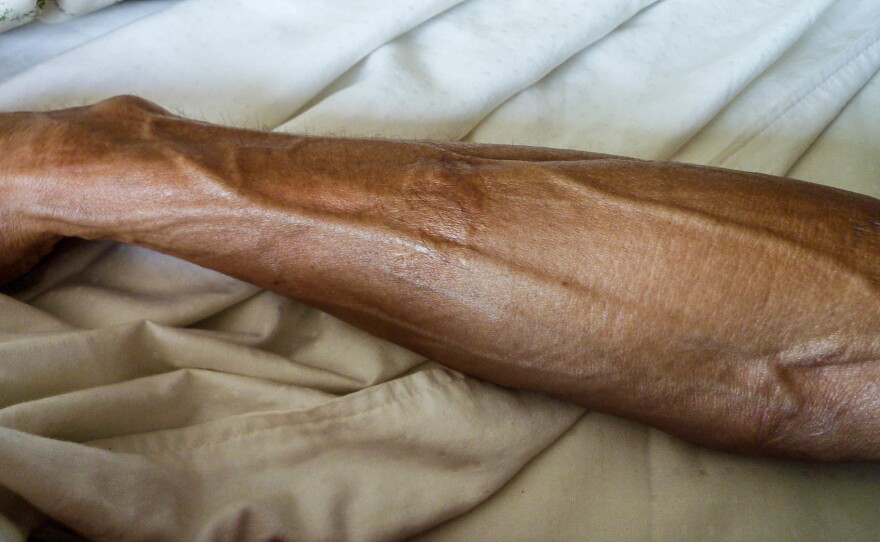







Photographer Gideon Mendel had won several prestigious awards for his pictures of the HIV/AIDS epidemic. But in 2007, he decided to hand over the camera to his subjects.
He co-founded an organization called Through Positive Eyes and began teaching basic digital camera skills to people who were HIV positive, then encouraged them to capture images of their own lives. Since 2008, they have hosted workshops in 10 cities around the world: Mexico City, Washington, D.C., Los Angeles, Rio de Janeiro, Johannesburg, Mumbai, Bangkok, Port-au-Prince, London and, most recently, Durban, South Africa.
This week, Through Positive Eyes will debut an exhibition at the Durban Art Gallery, featuring 145 photographs. It's the first exhibit to draw from all the workshops. The opening on July 17 coincides with the 21st International AIDS Conference in Durban, which begins the next day.
South Africans who participated in the Durban workshop will guide visitors through the exhibit.
The new exhibit will go on to tour South Africa and then make stops in Europe and the United States.
We spoke to Mendel about the project. The interview and the photo captions have been edited for length and clarity. Note: Some comments in the interview and captions are explicit. The photographers have asked that only their first names be used to shield their identity and protect their families because of the stigma associated with being HIV positive in their home countries.
You had been photographing the HIV/AIDS epidemic for a number of years. Why did you start the Through Positive Eyes workshops?
The initial impulse came out of a conversation [around 2007] with my sister, who is an HIV/AIDS doctor based in Cape Town. She was saying she finally had good access to medications and treatments for patients but still had a lot of people dying who shouldn't be dying. They were dying because of stigma, because they were coming to treatment too late or were too afraid to test.
[I was] also feeling that I've done what I could in terms of photographing [people with] HIV and AIDS. There are such huge limitations being the outside photographer, the non-positive photographer photographing positive people, often photographing poor people in poorer countries. I just thought it was time to explore ways of handing over the camera [to] actual positive people.
Why did you think that's important?
[Their] work is so much more interesting than what professional photographers could be doing. It's much more intimate. The people take cameras into their own lives. No matter how compassionate you are as a photographer, you're never going to achieve that level of trust and intimacy.
Can you tell me about some of the most memorable images.
From our workshop in India, there's one image, it's probably my most favorite in the whole project. It's taken by Priya in Mumbai, a self-portrait of her sleeping with her goats. Her husband and her children had rejected her because she was HIV positive, and she was very isolated and she spoke about her animals being so much closer to her than people. It's such a deeply sad picture.
Sadly, she passed away a few months ago.
Recently, I was really struck by one of our participants in Durban, Silungile. She's a traditional healer, what's called a sangoma. She helps people communing with the ancestors. She invited us to a sangoma dancing event. These are events where they do hours of dancing to bring them closer to the ancestors. We got there and she had the camera set up on a tripod, she was dancing, multitasking, she would go around and press the shutter on the self-timer and then she would go back into the picture and continue dancing. It just seemed so natural.
What are some of the themes that stand out to you?
There are some very clear themes when you start to organize the pictures and play with them. There's one theme of sexual intimacy, images which depict relationships and in some situations sexuality.
Magda from Mexico City was a strong advocate for saying that just because we are HIV positive doesn't mean we aren't sexual beings. There's this terrible thing that people feel because they're positive they have to be asexual. I said to her, well Magda, why don't you try and photograph yourself while you're having an orgasm. And that's what she did. She did this amazing picture. She held the camera and photographed herself at that moment.
And of course that's the kind of thing that you can do yourself in a way that feels appropriate and right and an impossible thing for an external photographer to do in any way that would be appropriate.
How do you talk to the workshop participants about representing their own experience?
Photographers like myself in the '90s were rightly criticized for portraying people with HIV and AIDS as victims and in very disempowered ways. What I'm very excited about is there is no external gaze in this. People are looking in on their own lives and choosing ways to represent themselves.
I think the strength of the project is that we don't prescribe what people should do. But we push people very hard in terms of trying to have a very high-quality product.
When I work with students, I'm a very tough critic.
How do you critique their work?
We'll have an initial day of training, and then people go off and photograph that evening and the next morning and then come back. We quickly edit their work and show the whole group what everyone has done. We give feedback and show things which we think work. And people often respond to them.
Who's the audience for the Durban exhibition?
I hope participants and delegates leave the AIDS conference and come to the Durban Art Gallery so they can experience this exhibition and these presentations by the participants.
The idea after the conference is over is to bring a lot of school groups through the gallery.
That part of the world [South Africa] has one of the highest rates of HIV infection. And it begs the question of why, particularly why adolescent girls in South Africa are so vulnerable to infection by HIV.
I think there's been a lot of attention and initiatives but people often feel fatigued by all of that stuff. So it's important to try and do more creative responses like this. I hope it might have some kind of an impact on the teenagers who go through the exhibition [and] who are particularly vulnerable to the disease.
Copyright 2016 NPR. To see more, visit http://www.npr.org/.






